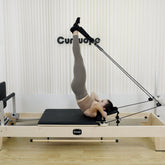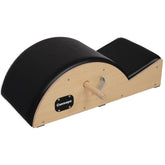What is the best Pilates Reformer workout plan for beginners?
Starting a new exercise program can be overwhelming, but with the right Pilates Reformer workout plan for beginners, anyone can get started and begin reaping the benefits of this low-impact exercise. Here is a sample Pilates Reformer workout plan for beginners that can help build strength, flexibility, and balance.

Week 1: Introduction to Pilates Reformer
During the first week, it's important to focus on the basics of Pilates Reformer exercise. A certified Pilates Reformer instructor can guide beginners through proper alignment and technique to ensure safe and effective movement. The first week can include basic exercises like footwork, arm circles, and leg circles.
Day 1:
- Footwork series: heels together, toes apart, toes together, heels apart (10 reps each)
- Arm circles: lying on back with arms extended to the sides, make small circles with the arms (10 reps each direction)
- Leg circles: lying on back with legs extended straight up, make small circles with the legs (10 reps each direction)
Day 2:
- Long spine stretch: sit on the carriage with legs extended straight out, round the spine forward and roll back up (10 reps)
- The Hundred: lying on back with legs in table top position, pump the arms up and down while holding a steady position with the legs (10 sets of 10)
Day 3:
- Side-lying leg press: lie on the side with the legs extended out, press the carriage out and in with the top leg (10 reps each side)
- Short box series: sitting on the box with legs extended, perform a series of exercises including spinal flexion, rotation, and side bending (5 reps each)
Week 2: Building Strength
During the second week, it's time to start building strength and challenging the body with more complex exercises. The focus should be on perfecting technique and gradually increasing intensity.
Day 1:
- Knee stretch series: kneel on the carriage with hands on the footbar, perform a series of exercises including knee stretches, abdominal curls, and pikes (10 reps each)
- Elephant: standing on the carriage with hands on the footbar, hinge forward at the hips and pull the carriage in with the feet (10 reps)
Day 2:
- Short spine massage: lying on back with legs up, roll up onto the shoulders and roll back down (10 reps)
- Side-lying leg series: lie on the side with legs extended, perform a series of exercises including leg lifts, circles, and lifts with the bottom leg (10 reps each side)
Day 3:
- Stomach massage series: kneeling on the carriage with hands on the footbar, perform a series of exercises including spinal flexion, rotation, and side bending (5 reps each)
- Backstroke: lying on stomach with arms extended, lift the upper body and arms off the carriage and circle the arms back (10 reps)
Week 3: Increasing Intensity
During the third week, it's time to increase the intensity of the Pilates Reformer workout. This can be achieved by increasing the resistance, adding more repetitions, or introducing new exercises.
Day 1:
- Long stretch series: standing on the carriage with hands on the footbar, perform a series of exercises including lunges, squats, and leg lifts (10 reps each)
- Push-up series: kneeling on the carriage with hands on the footbar, perform a series of exercises including push-ups, tricep dips, and pikes (10 reps each)
Day 2:
- Teaser: lying on back with arms extended overhead and legs in table top position, roll up into a V-sit and roll back down (10 reps)
Week 4: Putting It All Together
- Combine the exercises learned in previous weeks to create a full-body workout.
- Focus on flow and continuity between exercises.
- Continue to practice proper form and alignment and listen to your body's needs.
Additional Tips for a Successful Pilates Reformer Workout Plan for Beginners:
Consistency is key. Aim to practice Pilates Reformer at least two to three times a week to see results.
Here's a sample Pilates Reformer workout plan for beginners:
- Warm-Up (5-10 minutes)
Begin your workout with a few minutes of light cardio, such as marching or jogging in place, to get your heart rate up and your muscles warmed up. Then, spend a few minutes stretching your muscles, focusing on areas that feel tight or tense.
- Footwork (5-10 minutes)
Start your Pilates Reformer workout with some basic footwork exercises, which will help you learn how to use the machine and engage your core muscles properly. Some good footwork exercises for beginners include the toe taps, heel lifts, and leg circles.
- Mid-Body Exercises (10-15 minutes)
Next, move on to some mid-body exercises that target your core muscles, such as the hundred, the stomach massage series, and the spine stretch forward. These exercises will help you build strength in your abdominals, obliques, and back muscles, while also improving your posture and alignment.
- Upper Body Exercises (10-15 minutes)
After working on your mid-body, it's time to focus on your upper body muscles, including your arms, shoulders, and upper back. Some good upper body exercises for beginners include the arm circles, the chest press, and the backstroke.
- Lower Body Exercises (10-15 minutes)
Finally, finish your Pilates Reformer workout with some lower body exercises, such as the leg press, the hamstring curl, and the leg circles. These exercises will help you build strength and flexibility in your legs and hips, while also improving your balance and stability.
- Cool-Down (5-10 minutes)
End your workout with a few minutes of gentle stretching and deep breathing to help your muscles recover and reduce soreness. This is also a good time to reflect on your workout and set intentions for your next Pilates Reformer session.
This beginner's Pilates Reformer workout plan includes a mix of exercises that target the entire body, including the arms, legs, and core. The footwork exercises help you get comfortable with the machine and work on your alignment and stability. The arm and leg work focus on building strength and flexibility in the upper and lower body, while the bridge exercise targets the glutes and lower back.
Remember that consistency is key when it comes to exercise, so try to stick to a regular workout routine and gradually increase the intensity and duration of your workouts as you get stronger and more comfortable with the machine.





